Cases are hitting record highs around the world. That’s going to continue for another few weeks. While it does, and for a bit after it stops, there are disruptions all around as too many people are sick at one time. Thus, the CDC guideline adjustments, the hospitals under pressure, many schools forced to not meet in person (and then deciding to torture kids with ‘remote learning’ rather than giving them a vacation.)
No question it’s annoying, and for those in health care it’s overwhelming and terrible. I don’t want to minimize it. And if you care about avoiding this it’s going to be a lonely few months.
But compared to March 2020, this is nothing. We got this.
There are dissenting voices, but mostly the consensus seems to be growing that Omicron is milder, the center will hold, and our lives beckon.
Executive Summary
- Record high case numbers likely to continue for a few weeks.
- Hospitals under pressure but holding, deaths strangely low.
- If you get sick you should still do your best to get a negative test before ending your isolation no matter what the CDC says.
Let’s run the numbers.
The Numbers
Predictions
Prediction from last week: 3.5mm cases (+94%) and 10,800 deaths (+25%).
Results: 3.57mm cases (+96%) and 8,814 deaths (+2%).
Prediction for next week: 6mm cases (+71%) and 9,700 deaths (+10%).
On cases that’s another random bullseye. On deaths it’s a big miss, and given how little of the past cases were Omicron I don’t understand how the number came in this low, still below the level 2-3 weeks ago despite much higher case counts.
This is the dog that did not bark. The number damn well should have gone up a bunch, and it didn’t, and it makes me think that Omicron took over faster than I previously thought. I can’t think of another way to explain it, and the fact that I’m using that to explain it seems like very good news going forward.
I do expect deaths to start climbing, how could they not, but we keep not seeing big jumps there, so I’m going to downshift my expectations there even as lagged cases start rising faster.
Deaths


Report that deaths among young people are up 40% from pre-pandemic levels, in the context of life insurance. This sounds terrible and is terrible, but in terms of how one should live one’s life young people are still very unlikely to die and shouldn’t take minimizing death risk as a major life task except when considering doing actively risky things like skydiving, or putting oneself at risk of violence.
Cases

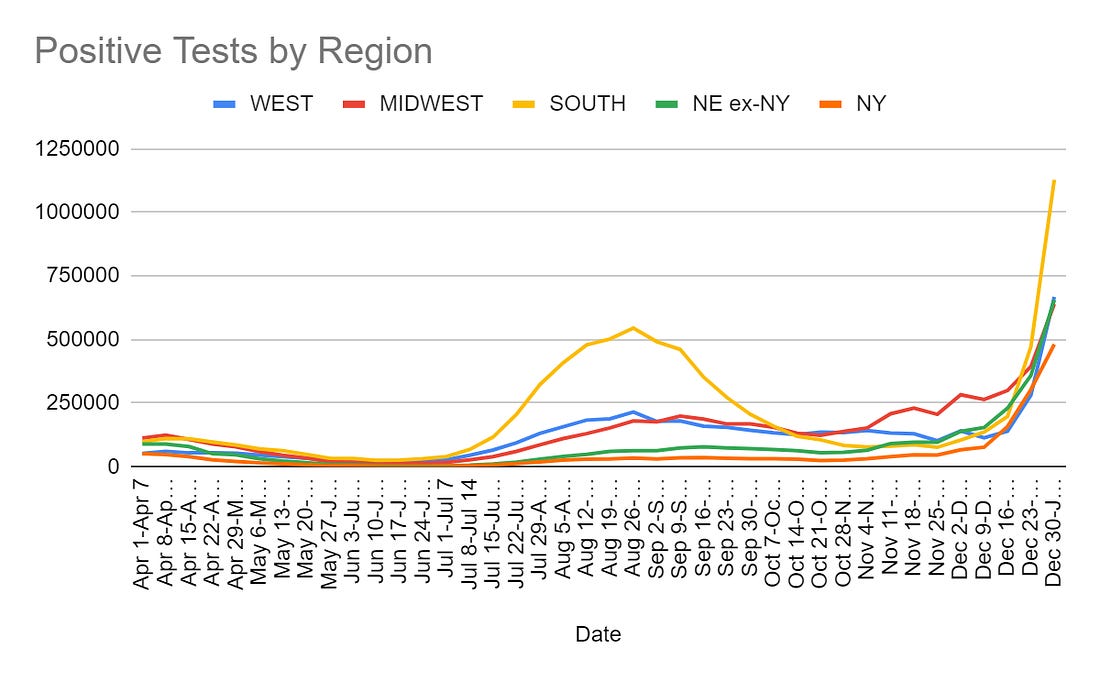
It looks like Manhattan has indeed peaked, and maybe Brooklyn, and maybe NYC overall. If that’s right, then things will have held together well.
Boston on the other hand looks like it’s still headed upwards, currently at more than five times the previous peak.
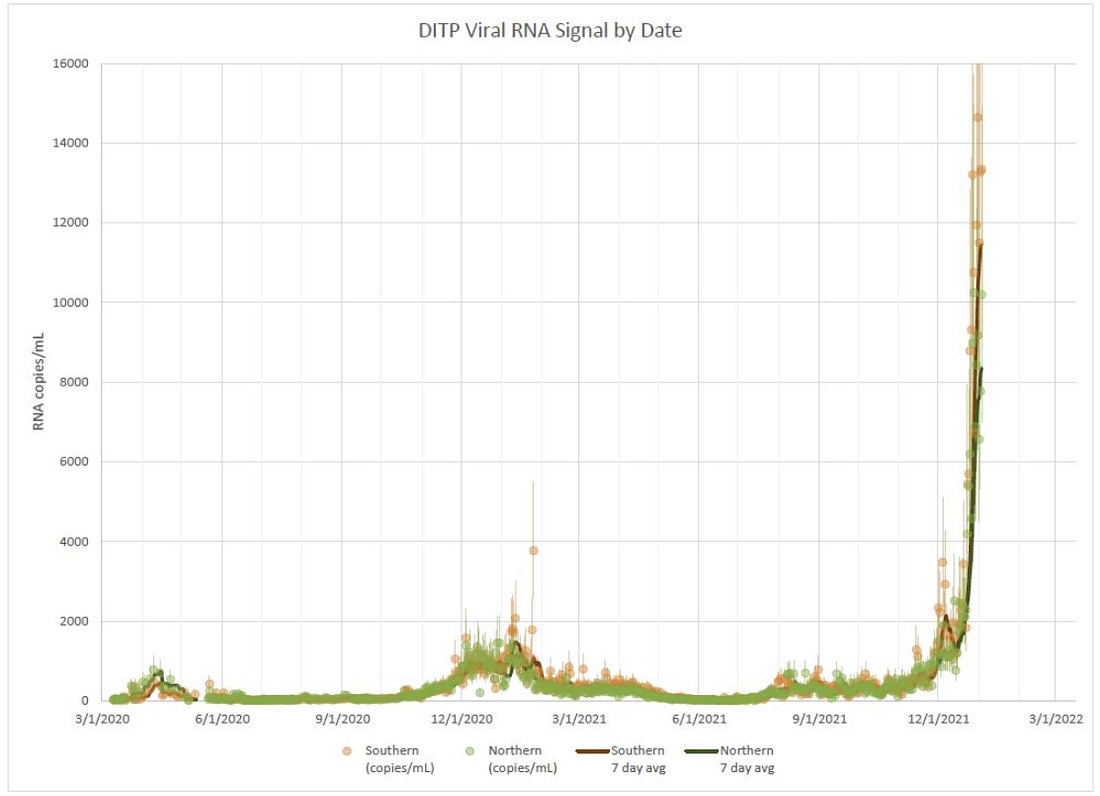
Washington D.C. schools did systematic tests, found 5.8% of the tests came back positive. This was a lot of kids, so probably a lower rate than the city overall.
A week ago fully one third of NBA refs were in Covid protocols.
Vaccinations
CDC shortens length of time to wait for a Pfizer booster to five months. Six months was, of course, yet another arbitrary round number. And now we have this handy easy, not confusing chart, note that in some places boosters are mandatory soon after they are permitted.
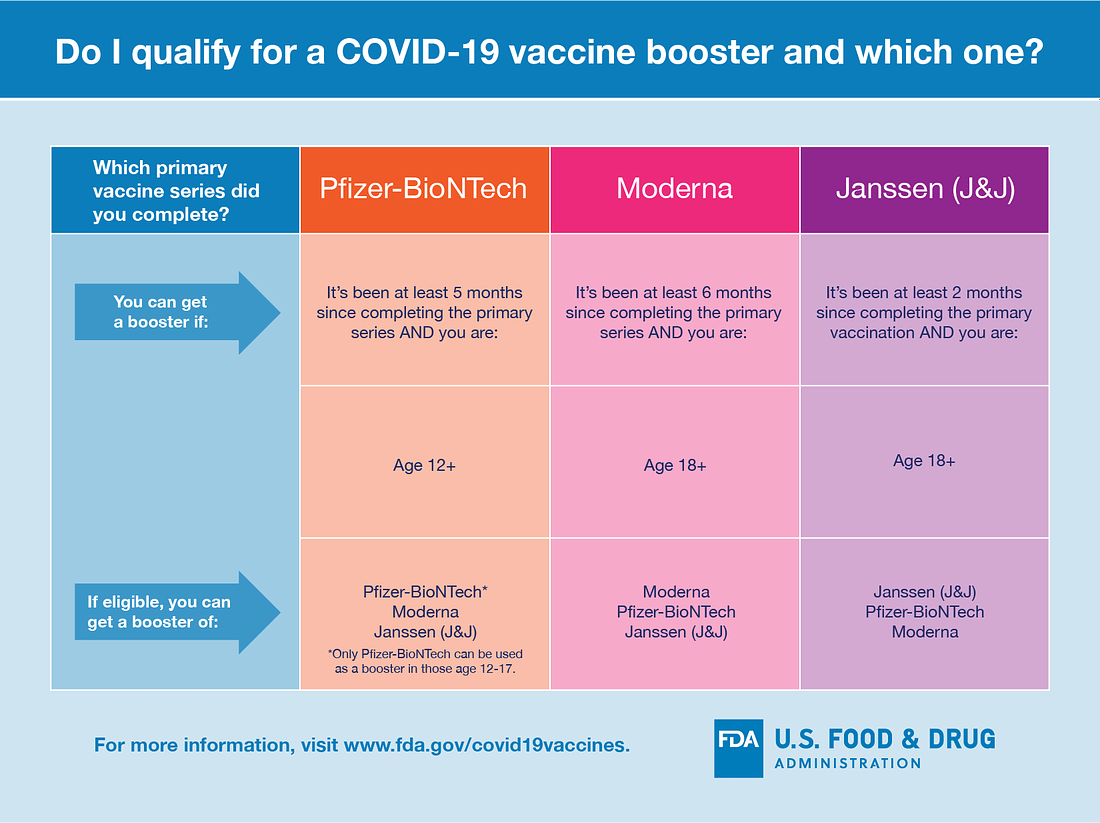
The FDA decision to do thid bypassed VRBPAC. They didn’t consult their advisory committee. This new thing where when we don’t need their input we don’t ask for it? Excellent.
ACIP, alas, could not as easily be avoided, here is a recap of that.
Which includes this unrelated gem:
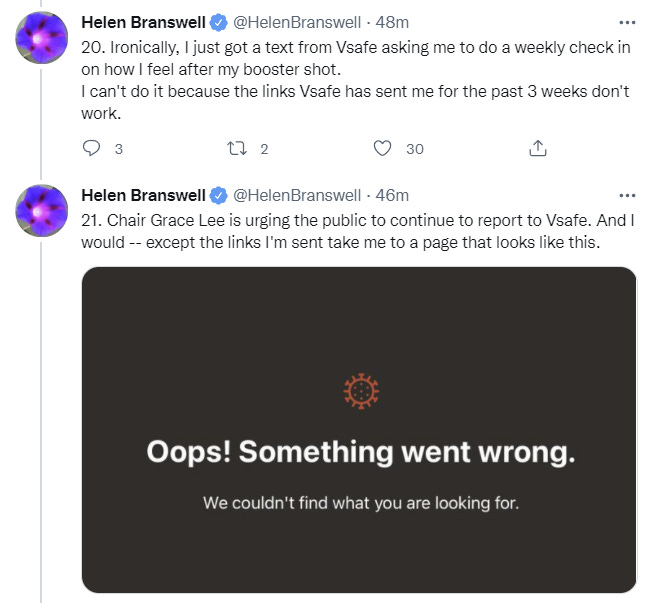
So, anyway, yeah, now you’re worried about boosters limiting vaccine supplies for other countries? What changed, exactly?
Also, it’s one thing that we haven’t approved Novavax, we have plenty of supply ourselves so we don’t need it. It’s another thing that we haven’t approved the manufacturing of Novavax?
It is still unclear how many doses Novavax will be able to provide next year. A company spokesperson said its goal is to produce 2 billion doses in 2022. But there are lingering concerns among top Biden officials and global health advocates about Novavax’s manufacturing facilities in the U.S. and Europe and whether the company can present the data necessary to obtain the regulatory approvals necessary to distribute doses made at those locations any time soon, according to the individual with direct knowledge of the administration’s thinking on Novavax and another individual with direct knowledge of the company’s communications with the administration. Both sources requested to remain anonymous to speak more freely on the matter.
I don’t know what to say to that, at this point. The boosters, over the long run, increase demand and will result in matching capacity and supply. It’s our delaying and denying of the booster plan that made this a problem at all. Meanwhile, we continue to hold up production rather than working to expand it. If we wanted more vaccine doses, we would pay for them and allow them to be created. We didn’t, so presumably we don’t want this very much.
Vaccine Mandates


That’s the strategy. The strategy is to punish the people who won’t follow his orders. To piss them off. And continue doing so, until the end. This isn’t about precautions that make physical sense. This is about punishment and coercion, full stop. There’s no longer any pretenses otherwise, on any level.
The alternative strategy that he needs to explicitly say he won’t do is to vaccinate the non-compliant population by force, or imprison them.
That doesn’t mean that there’s no benefits in terms of prevention or slowing the spread, but he’s no longer pretending that they are driving the decision.
And again, I appreciate the honesty here. It’s important not to punish such honesty, while still opposing the policy if you don’t think that we should be strong-arming people into getting vaccinated.
Similarly, if you were to punish the unvaccinated by banning them from buying marijuana and hard liquor, you are once again owning your motives.

Italy isn’t messing around either, but seeks to maintain plausible plausible deniability.
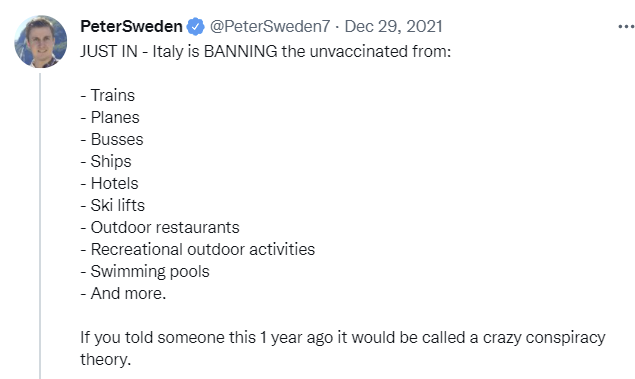
Djokovic
In other news, nope, no idea, I got nothing he could possibly do.

Yes, obviously he could have gotten the vaccine anyway to avoid such issues. It seems quite foolish not to do so, given the amount of travel he does, and I continue to not see this as a big deal.
Except here’s the thing. He did go through the required process (WaPo via MR).
According to a person close to the tournament with direct knowledge of the sequence of events, Djokovic followed every step of the country’s visa process properly. Moreover, the person said, Djokovic’s medical exemption was granted with all identifying information redacted, ruling out the possibility of favoritism.
Djokovic has had Covid-19. I believe he’s had it twice. One could respond with ‘that’s why you need a vaccine mandate’ but now that both infections are in the past, there’s no physical-world-model justification for denying him entry into Australia beyond the need to enforce the law. If this is additionally them about-facing and disobeying the law, it makes no sense in any way other than grandstanding and the punishment of someone that power doesn’t like.
Letting him get on a plane with one understanding (assuming his understanding was reasonable) and then turning around and doing this is another level. Some would say the cruelty is the point.
The argument in favor of keeping him out is that there’s no systematic way to verify who has previous Covid infections, and we don’t want to make an exception in this weird case where we can be confident the infections happened, or it wouldn’t be fair. There aren’t enough cupcakes for the whole class, so we throw away all the cupcakes. Or, of course, that you don’t like him.
Paxlovid
In order to get Paxlovid in New York, you need to have mild to moderate systems, be able to start treatment within five days of symptom onset, be over the age of 12 and weigh at least 40kg, and have one additional risk condition. I’d have preferred a much higher age minimum, but otherwise that seems sensible.
Then the question that seems to have no good answer. Give it to the vaccinated, or give it to the unvaccinated?
The solution is, whistle in the dark and count race as a ‘risk factor’?
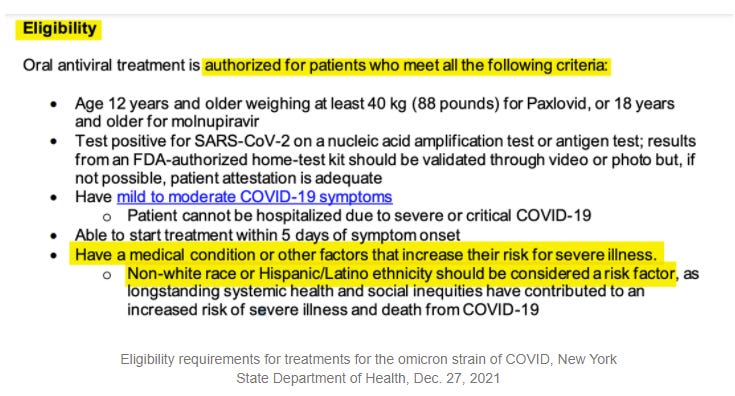
I can confirm, these are guidelines that were sent out.
I can also confirm that there were no other explanations given on what does or does not count as a risk factor.
Given the options of giving to each according to their needs or judging by the content of their character, they took at third option and went with the color of one’s skin.
This seems to be the CDC’s explanation:
Long-standing systemic health and social inequities have put various groups of people at increased risk of getting sick and dying from COVID-19, including many people from certain racial and ethnic minority groups and people with disabilities.
Studies have shown people from racial and ethnic minority groups are also dying from COVID-19 at younger ages. People in minority groups are often younger when they develop chronic medical conditions and may be more likely to have more than one condition.
They’re also less likely to be vaccinated. Policies that discriminate on the basis of vaccination status, that many on the left support and that many cities have implemented, have a disparate impact on the basis of race.
It’s important not to make too much out of this. If you have no ‘medical condition or other factor’ that increases your risk for severe disease, and presumably age counts as an ‘other factor,’ you’re not at much risk, and you shouldn’t be getting Paxlovid given our current shortage. If you actually need it, you’ll be eligible. Remember that when it was time to show eligibility for boosters, something like 75% of people technically had at least one ‘risk factor.’
Then again, if a bunch of people who don’t need Paxlovid get Paxlovid (including anyone who is white and who realizes how easy it still is to have a ‘risk factor’) then it’s a lot more likely there won’t be any Paxlovid to give you.
One could reasonably point out that given systemic differences in ability to navigate the system, and their reduced willingness to actually want a new anti-viral Pfizer drug, that those who are eligible via this rule will almost certainly be much less likely to get Paxlovid than similarly at-risk white people. The same would presumably be true if we instead made being poor or a lack of education a risk factor.
No matter what you think of such arguments, we are explicitly allocating scarce life saving medicine on the basis or race. This seems worth noticing.
The good news is that the White House doubled our Paxlovid order. The bad (non-news) is that they needed to do that in the first place.
Ministry of Truth
This was in accordance with Twitter’s ‘five strikes and you’re out’ policy. It’s not easy to get permanently suspended this way. You don’t quite get twelve chances to clean up before you’re asked to leave, but you certainly can’t say you were never warned.
Thus, she makes a good test case. What were the five strikes?
The first one seems to have been election-related rather than Covid-related, nothing you wouldn’t expect.
We were unable to locate the second violation.
My assistant did find this one, which we think (?) is the third one.

That does seem rather like ‘dangerous misinformation’ about Covid-19, on two distinct counts.
Yes, there’s a version of the ‘under 65 and non-obese’ claim that is true and important, but this is importantly different from that. I can see why one might find it unacceptable.
Then there’s the ‘vax related deaths’ claim, and yeah, stating that as fact does seem exactly like what a ‘dangerous misinformation’ policy is designed to stop.
There were also a lot of anti-vax things said that didn’t result in a strike, pretty much a constant stream of them.
The fourth warning was likely this one, saying that vaccines do not ‘reduce the spread’ and neither do masks.
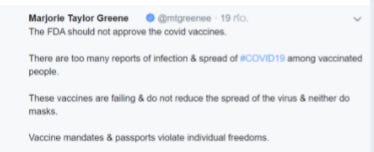
WaPo included this description of the final one, and it echoed that second claim from the third suspension, so there was very clear warning here.
The tweet at issue claimed coronavirus vaccine deaths were being “ignored,” citing the VAERS data. But the database itself warns that the information can be incomplete, inaccurate, coincidental or unverifiable, saying that the “reports alone cannot be used to determine if a vaccine caused or contributed to an adverse event or illness.”
That defense is quite the non-sequitur. It’s ‘misinformation’ to claim that things are being ignored in a database because that database says that its data might not be accurate or complete? That doesn’t sound like evidence against her position. Whenever I see such arguments used I update:
- There might not have been good arguments.
- Even if there were, they’re not going to be used to decide what to do next time.
- If we can use this kind of justification to label something ‘misinformation,’ then that word means whatever power wants it to mean.
- Thus, ‘dangerous misinformation’ is ‘information that power doesn’t like.’
I can’t even tell, from the description, whether her statement was even false.
I presume it was false, especially given the previous tweet, and that she was claiming a similarly massive number of (as far as I can tell, completely fictional) deaths from vaccinations. Which is misinformation, and is dangerous. I also think that censoring that kind of statement is a reasonable thing to consider doing. But the rules seem to consistently get written in a way that does not differentiate between this and a similar true or good faith statement, and instead give power the ability to censor whatever they dislike.
Over the long term, that policy does not go anywhere good. But it’s not like this should have come as a surprise.
Reactions were as you’d expect. That first one sums up all sides quite well, I especially like the (intended or unintended) ambiguity here about who are or are not being fascists.
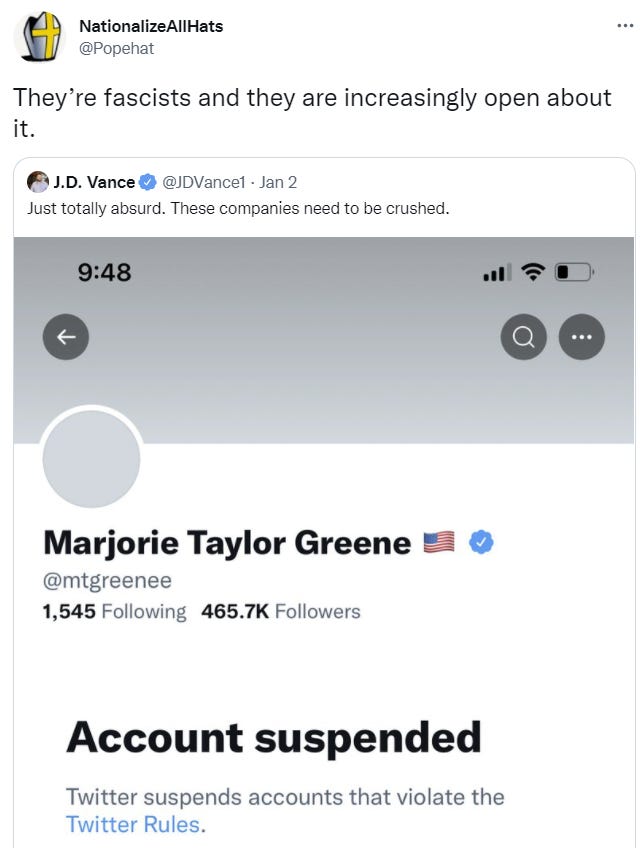
NPIs Including Mask and Testing Mandates

Interesting timing, but you know what they say, the second best time is right now.
Some fake KN95s got distributed over the weekend. The 95 means you stop 95% of particles, and by all reports these very much do not do that.

What they are still good for, of course, is fulfilling mask requirements. And presumably many people will prefer the feel of these, exactly because they fail to be an effective mask. Adverse selection is a real problem here, unless what you care about is the requirement.
NYC Testing cites for this week. Is there a reason this needs to be updated so frequently? Also clearly extremely incomplete.
It could be much worse, and some places it is, here’s an example of waiting a week for a PCR test. At which point, why bother?
Also, as a general principle, our procedures that decide which particular things to mandate or forbid (in terms of Covid-19 and NPIs, or anywhere else) is not well-principled, well-sorted or well-ordered, and often dumb rules are implemented instead of better rules.


If X and Y physically interact such that X relies on Y, it can make sense to only do X if you also do Y. To extent you have control over both the decision on X and the decision on Y, and Y strictly dominates X, then you shouldn’t do X without also doing Y. But the wisdom of our collective decision to do or not do X doesn’t much matter when deciding whether to do inferior independent option Y. You should do the prevention that makes sense on the margin, and not the prevention that doesn’t, in light of whatever decisions you’re forced into and the conditions that exist, even if those decisions were deeply stupid.
That extends beyond Covid-19. Arguments from consistency should mostly be ignored if you’re being forced to be consistent with decisions over which you have on control. Otherwise, once someone manages to sneak through one dumb decision, you’ll end up with a tsunami of additional dumb decisions. There’s always a dumb decision, in all directions, somewhere.
Also:
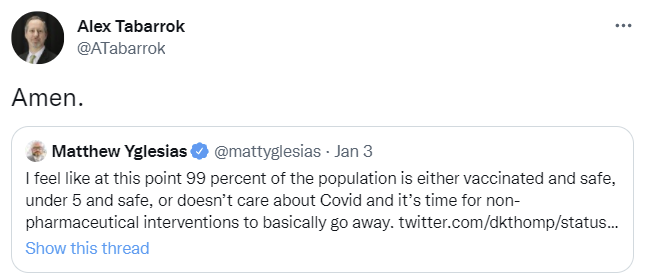
Given we’ve waited this long, I might wait a few weeks to be sure the hospitals will hold up in rural areas, but mainly, yes, amen, and let private citizens make their own private decisions based on what’s right for them.
Think of the Children
Should we mandate boosters for young children? I mean, obviously no, we should not do that, it’s too late for it to make a difference, the cost-benefit is unclear given how safe kids already are after two (or one, or zero) shots, and the amount of backlash would be severe. Yet the first question for anything approved is always ‘should this be mandatory?’
A reminder of what record numbers of child hospitalizations means.

New York City schools instead are determined to stay open, so they’re asking teachers to come back five days after testing positive, without a negative test and despite mild Covid symptoms (article). If the symptoms are ‘improving’ then they don’t even have to be ‘mild.’
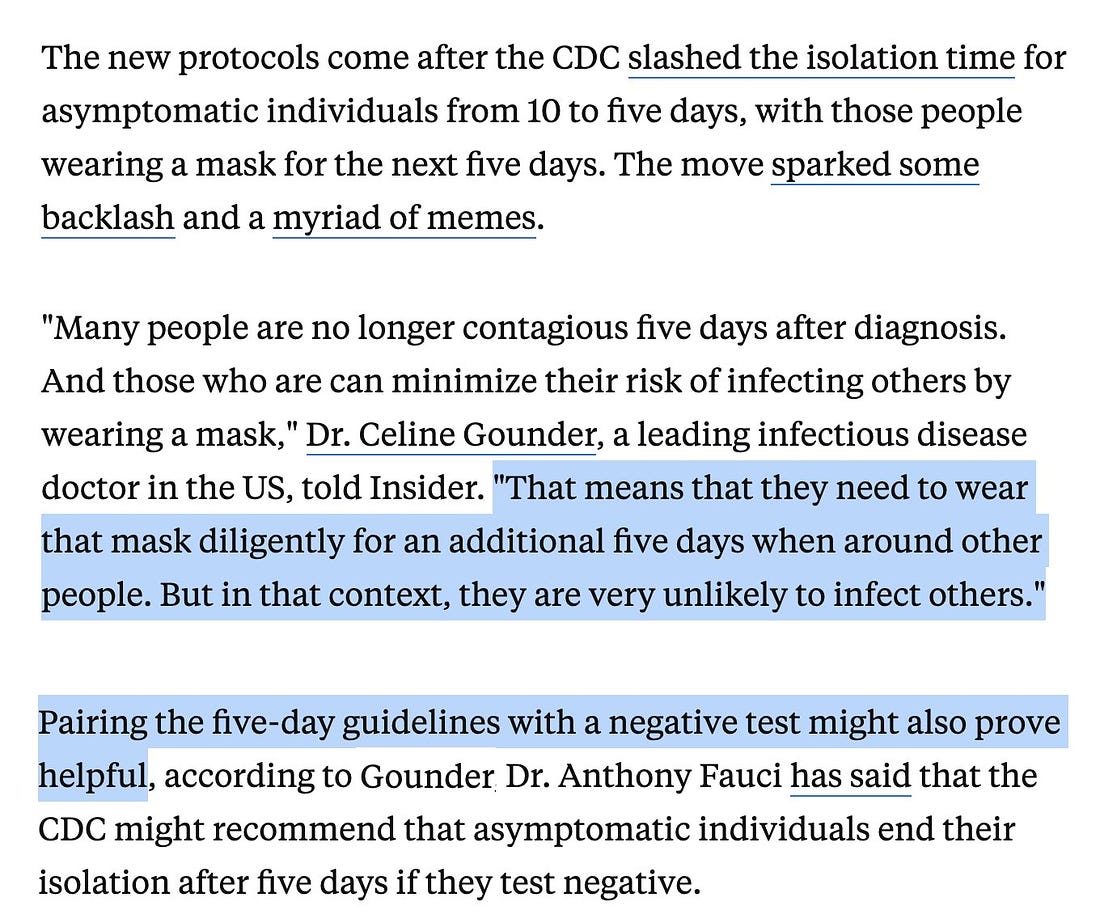


Did you know that schools are ‘one of the safest places’ for children during the pandemic?
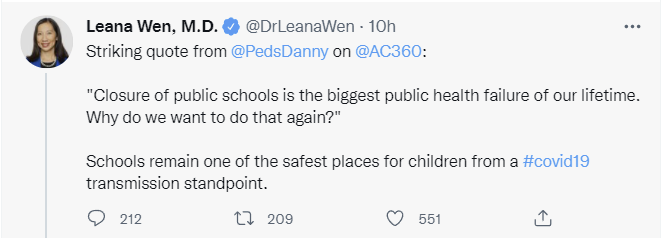

And did you know that this is no way to grow up (article it links to is NY Times)? As in the NY Times itself is now pushing the narrative (because everything in that paper is pushing a narrative) that the disruptions we’ve imposed have put our children into crisis, And That’s Terrible, as opposed to before when it somehow wasn’t terrible and you were instead terrible for objecting to it.
So weird that suddenly, now, things other than case counts matter and it’s good to do a cost-benefit analysis about how much what you’re doing is messing up children’s lives. And all of this is suddenly ‘not surprising.’
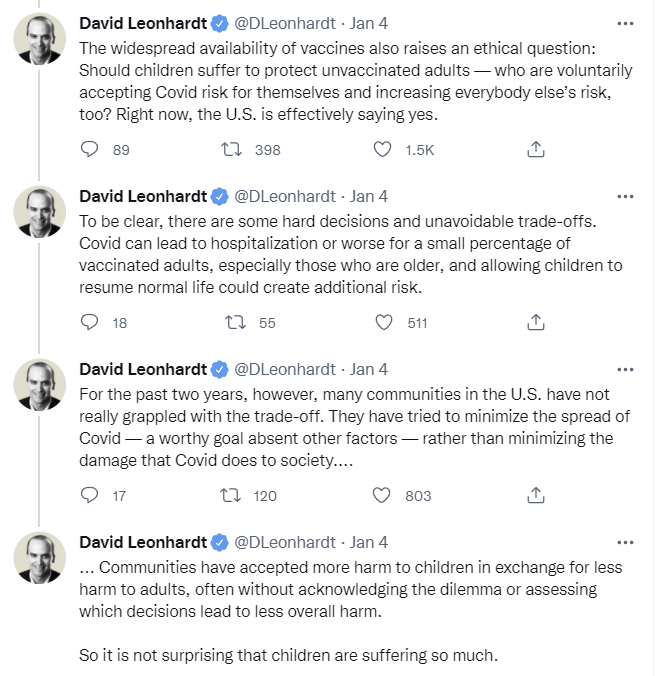
My memory is same as Nate’s here, cost-benefit was anathema, also yes all of this was obvious but denied. I also worry how much emphasis was placed on suicides, both because it’s a lot of deaths and also because of the implication that the only way to rhetorically answer death is more death.
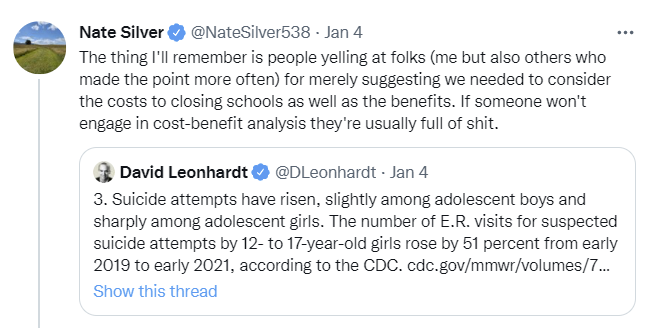
If you’re a parent whose children were forced into a year of ‘remote learning’ in the name of pandemic safety, you might be wondering, what changed all of a sudden? If schools are safer than not schools, in addition to the mental health and learning disasters that come from ‘remote learning’ as implemented by a vindictive system looking to mimic the punishments of ordinary schooling rather than teach children, then what the hell were we doing that whole time?

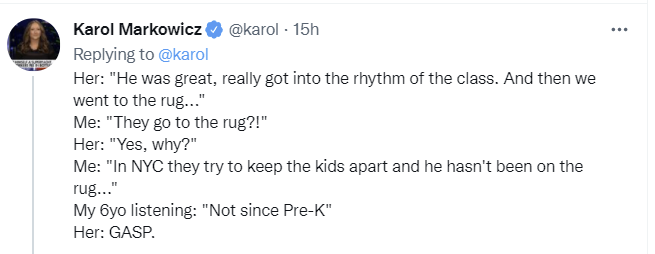

Meanwhile, schools are acting terrified in all sorts of different ways, which doesn’t seem necessary if they’re so safe. But also they’re indoors, often poorly ventilated, often with many people in the same room, so how in the world could they be ‘one of the safest’ places to be? What physical model could this be describing? Or is this describing something else entirely?
It’s no wonder some are feeling more than a little gaslit.
While we also scare the children. The message I want such a child to get is that getting Covid-19 is nothing for him to be afraid of, he’d be totally fine. I worry telling him to eat quickly sends the wrong message.

Also, crazy talk here, but what is so sacred about lunch? We’re taking kids, putting them in jackets and having them eat on the sidewalk, when we could simply… give them a bigger breakfast and then have them wait until they get home? Is that so completely insane? At about that age I remember being sent to a camp that served non-kosher food and my parents wouldn’t let me eat it and I was the kind of kid who followed such rules, so I often ended up eating once a day, and this wasn’t only fine, it taught me a useful life skill, that I use almost every day.
So you know what, how about let’s not do lunch.
I do realize it’s different for those who need subsidized school lunches, because our society is pretty terrible about how it gets its children in need fed.
The only good counterarguments to all this that I’ve seen are:
- Schools as they typically exist are terrible.
- Whether or not schools are terrible, kids can and do recover from missing even quite a lot of school, all the time.
If you think typical schools are dystopian nightmares, you’d be inclined to welcome a break from them. The thing is, even if schools are such nightmares, remote learning as implemented by the United States was clearly much worse. It carefully recreated all the negative aspects of school such as being constantly forced to sit motionless all day as a dominance exercise, and adds new ways and new levels, while failing to capture the benefits of school, such as social contact with other humans, or making any attempt to teach things.
This is not the kind of thing that old ‘missing school’ studies were measuring:
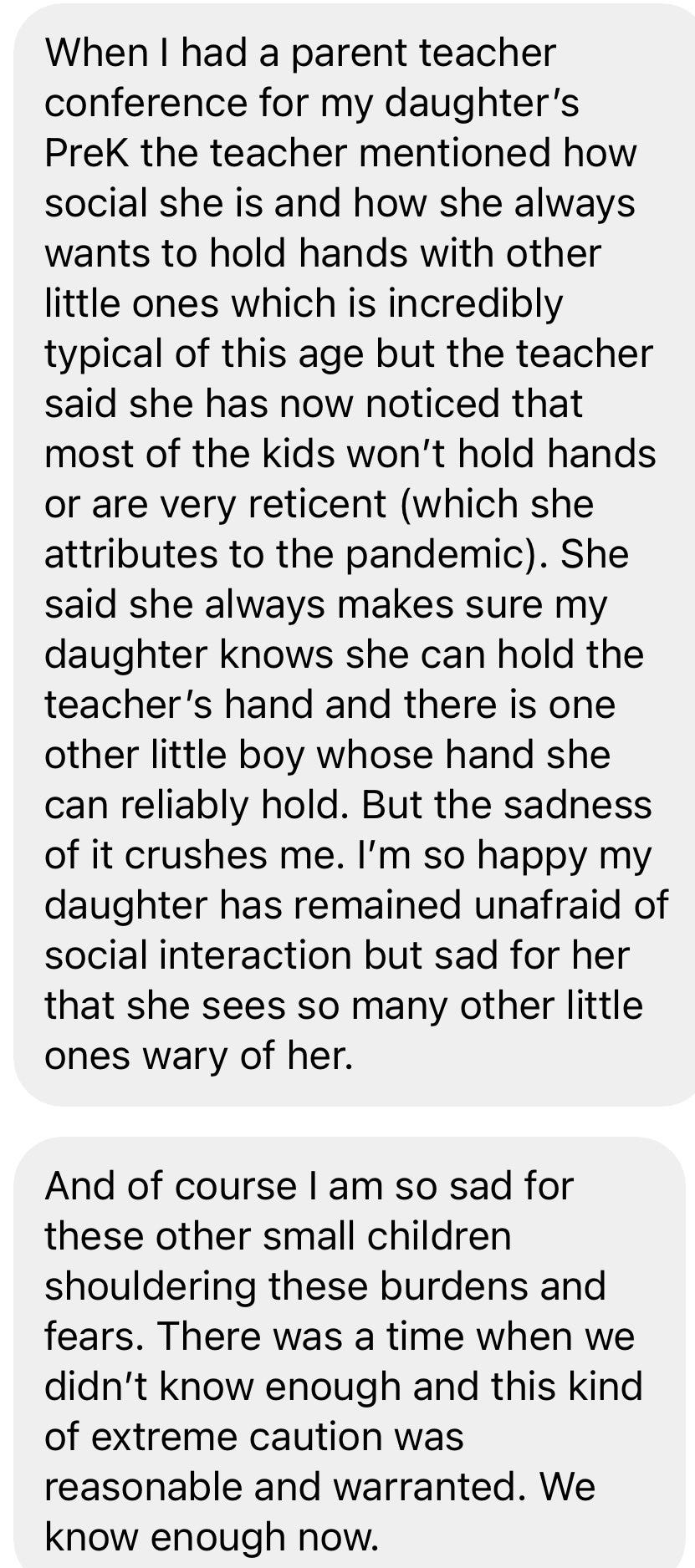
I’ve seen some of this as well, although thankfully less.
My model is:
- If kids got to stay home, use Khan Academy, play games, read books and listen to the radio, play outside with the other kids and otherwise be the age they are, help around the house and learn practical stuff and from their parents and others around them, that would be like ‘missing a lot of school’ – if the alternative was be allowed to be a child – then the kids would very much be all right.
- If the kids are forced into ‘remote learning’ then you’re torturing them all day while both failing to teach them much of anything other than how screwed up everything is, and also crowding out opportunity and energy for either living life or otherwise being able to learn. You’re also combining that with not letting them see other children or other people’s faces. Meanwhile, we’re teaching all our kids to be obsessed with the ‘danger’ of catching Covid-19, as something central to life.
- Yes, this is going to turn out very badly.
- There’s a reason I home schooled our kids rather than doing remote learning.
Matching all this is the suicide data.
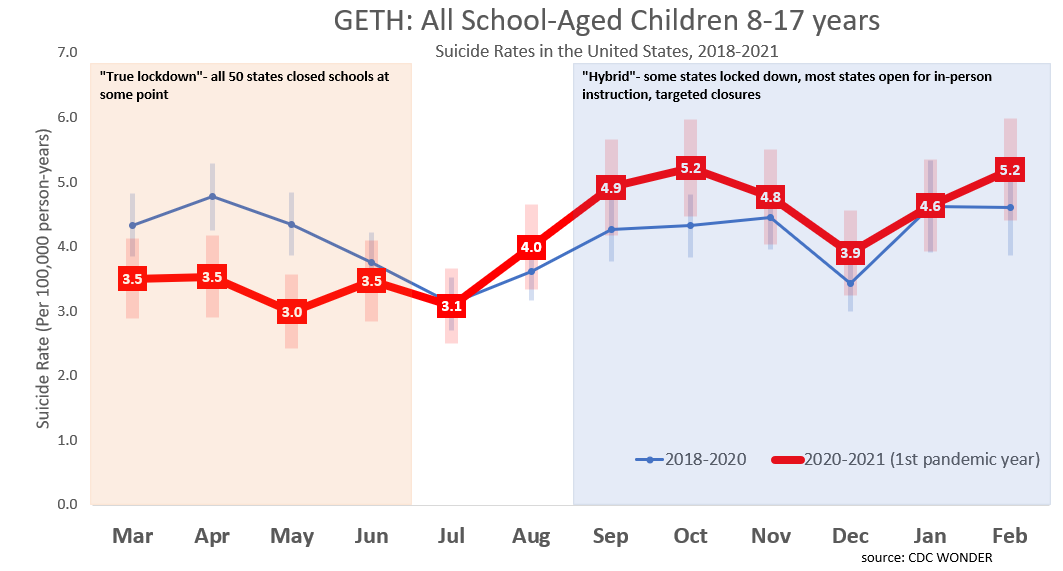
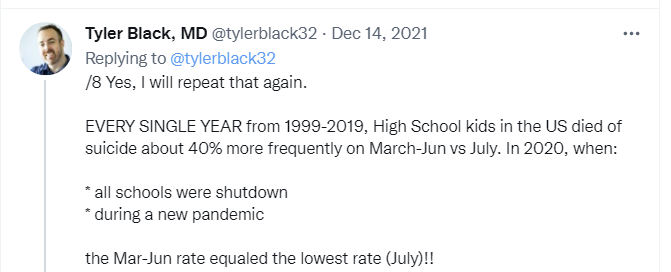
Normally when kids are in school, they are more likely to kill themselves. This year, when we closed the schools, kids killed themselves less. Then, when we went to ‘remote learning’ kids killed themselves more.
From the anecdotal experiences I’ve hard about, and I mean all of them, it’s not hard to see why.
In a related question, is this schools having a problem or is school a solution?
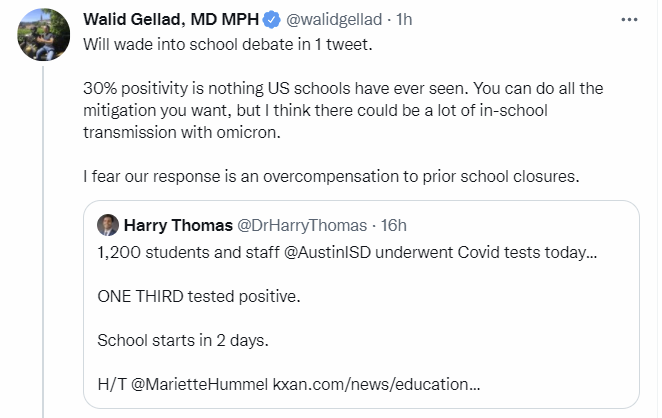
Does this mean the schools are dangerously unsafe and have to close, because a third of students are positive? Or does it mean that not being in school is dangerously unsafe, and the schools need to (or might as well) stay open?
Should you close the schools? Should you close to schools to everyone who tests positive? Or should you close the schools to everyone who tests negative?
If you put the two thirds of students who you don’t think have Covid-19 into a classroom, you’re going to be wrong, because on average you’ll have one student who got infected yesterday and one from two days ago. So everyone gets exposed anyway.
Whereas if you put the one third of students who definitely do have Covid-19, since the false negative rate is super low, into a classroom, then everyone already has it, and no one gets exposed. Of course, you’d then need to ensure the teachers also have it, but that presumably a lot of them do as well, and they’re not exactly otherwise in high demand, so sure, why not?
The best part of this plan is that over time it improves. Everyone who has had Covid-19 in the last few months is also fine, so pretty soon the classroom is full again. Then, once things settle down, the kids who were always negative can come back.
Fun little exercise. There’s so much room to actually improve things if we cared mostly about outcomes and not what things looked like, as many good reasons as there are that this absolutely does not work. So just kidding, baby. Unless you gonna do it.
Yet another standard ‘colleges are imposing crazy requirements’ post, this one a guest post on the Bari Weiss substack. Pre-Omicron, such posts were transparently correct, the universities were doing Obvious Nonsense. In March, any remaining such policies will once again be Obvious Nonsense.
And also, right now, such policies are still Obvious Nonsense, because they are neither necessary to protect anyone nor are they sufficient to stop spread on campus. If you don’t want your students infected in January, you have zero options. You do have the option to ensure they are not infected on campus by not opening the campus, in which case the infections will not be your fault, but the infections will still happen.
When there are 146 positives upon return to campus like there were at Stanford that’s not on you. That presumably is what such policies are about.
Having been soundly trounced by Georgia, the University of Michigan goes from daily to weekly testing, buying up to six days of the school being open. This makes the data much less useful for making good decisions, but potentially less useful for making bad decisions as well. Value of information can sometimes be negative.
And that’s why Yale students are under quarantine until February 7 and not allowed to eat at outdoor restaurants.
Zeynep’s First Law
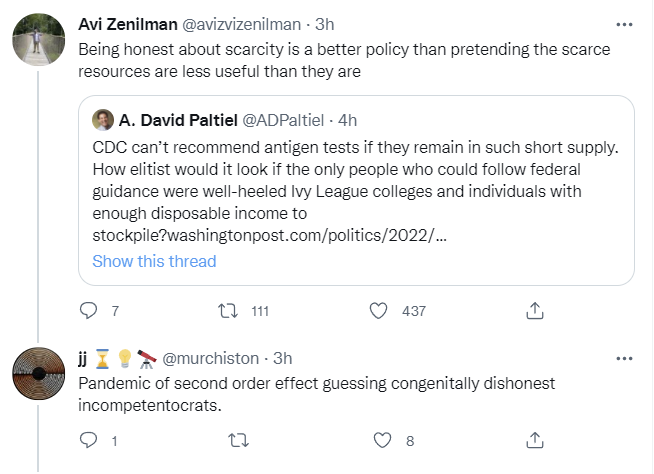

What, never? Well, hardly ever. And not by default.
I think she may have dropped not one but two, as the next section will show.
CDC Guidelines Revision Part 3

Bob Wachter suggests CDC should have told the truth about why it was issuing its guidelines, and isn’t even suggesting the whole truth. He’s suggesting merely that they not lie about tests not working on day five, not the crazy talk of admitting that they’re compromising a bit to keep society running.
This or something similar seems like what all the reasonable people are suggesting makes sense, it’s simple, it’s being done elsewhere, it makes perfect sense.
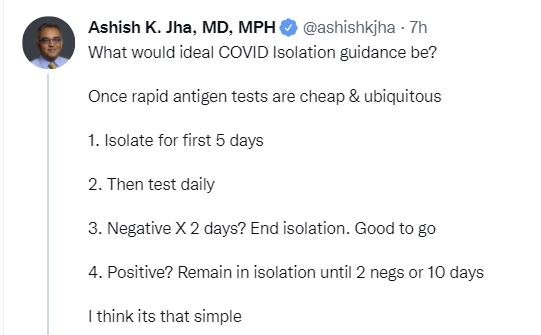
I am not sure we can afford to wait for the second negative test, nor do I have a good idea how much extra value that second test provides, but even one would be a large improvement when it’s available.
And this keeps it simple, as opposed to attempts to explain current policy.

We also have The Daily Show explaining in video form (~1min).
Cause yeah, this isn’t simple at least as written (link to policy).

That’s a lot of words that effectively say ‘isolate for 5 days, then mask for 5, and if you have an actively positive test after 5 days, then isolate for the full 10 days.’
It’s a sign both of the CDC’s inability to cleanly communicate, and the amount of trust they’ve lost, that everyone is calling this complicated, and calling for ‘simpler’ things that are more complicated than what this is trying to do.
Meanwhile, the CDC’s own guidelines say that 31% of people are still infectious on day 5.
It’s also worth noting that if you’re exposed to Covid-19, you’re asked to isolate about as much as if you test positive, if anything longer because they have you test afterwards since who knows when you might or might not have gotten infected. So it’s ‘better’ to actually be positive than be ‘exposed’, even though basically everyone not working hard to avoid exposure is exposed.
Or consider their planned new policy.

There’s also always the incentives.

Of course, no one knows what the rapid test said, so if you choose not to look it doesn’t actually get you off of any real hooks. It’s Not the Incentives, It’s You.
As an example of how this works in practice, what you’re supposed to do if you test positive in the DC area.
Anyone else want to give it a shot? How about the CDC director?

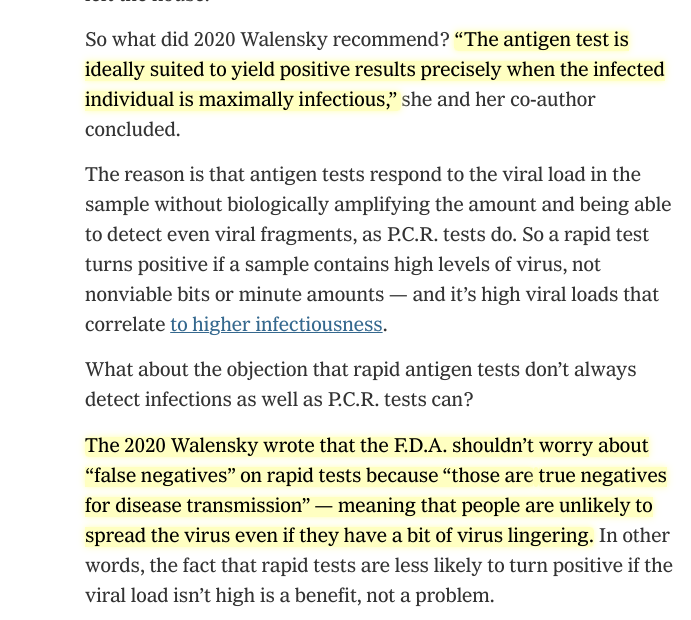

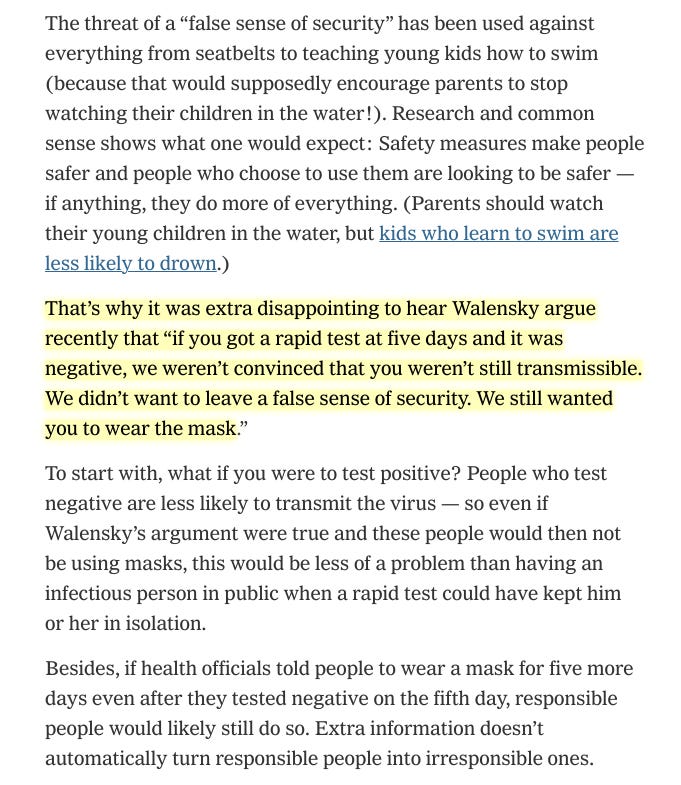
That might want to be her second law, e.g.:
Zeynep’s Second Law: Extra information doesn’t automatically turn responsible people into irresponsible ones.

California moves to 5 days and adds the obvious testing requirement.
Tom Frieden actually explains and defends the CDC’s actual policy, considers it reasonable because tests aren’t always accurate. This doesn’t seem like a good argument, but the implicit ‘we must muddle through as best we can’ carries weight.
What, Me Worry?
In today’s no s*** sherlock headline news:

I mean, I knew that, and I’m still willing to bet this one doesn’t replicate, because, I mean, they’re doing stuff like this, and that stuff is meaningless and doesn’t replicate, it’s the law.
For the tests examining how well people maintain information, participants had to match pairs of numbers and symbols according to a specific set of rules. Study authors also examined the group’s decision-making skills using a test of risk management. Each person could either choose a “certain” option where they definitely won $75, or a “risky” option where the odds of winning $0 were only 25 percent and the odds of winning $100 were 75 percent.
Those are two options each with an expected value of $75, so I have no idea what decision making they plan to test there?
The team also discovered that worrying about COVID-related issues distorted a person’s ability to evaluate certain risks. They underestimated the chances of likely outcomes occurring (like winning $100) and overestimated the chances of unlikely possibilities occurring (like winning nothing at all). The team believes this impact on decision-making abilities may influence some people when they’re considering certain topics — like getting the COVID-19 vaccine.
I can certainly believe (but also could almost as easily disbelieve, or believe the opposite) that people who worry a lot about Covid-19 also obsess over other small ‘risks’ but what does it mean to ‘underestimate the likelihood’ of something in this context? I tried to actually skim the paper, to no avail, leaving even more confused.
Which is a great joke, but also what he’s saying is that one can’t plan one’s life around constant testing. I very much agree. Testing is important but there are those who have gone completely overboard. ‘
In related news, a study finds getting vaccinated is good for mental health, reducing symptoms of depression and anxiety by 30%.
Hospitals
A lot of health care workers are sick, but that’s not the only reason staffing is short.
The health care quit rate has risen to 3% per month. It’s an impossible job that’s only getting harder.

(Quits are high in other areas as well, some data at the link.)
Rhode Island hospital is at 113% capacity, but only at 65% of what capacity would be with normal staffing, which means almost half of capacity there is currently offline. It also means that you can be at 113% of temporary capacity.
Hobson’s latest update on the state of UK hospitals. London looks like it will hold, but serious worries that other areas will fail to echo London and things could get worse, especially as more elderly get sick. And even if ‘the hospitals hold’ that doesn’t mean conditions are good. Waits are still often 12+ hours long, everyone is stretched beyond their limits.
Here’s some interesting data, and wait did you know the ‘for Covid’ share of the patient population this whole time?


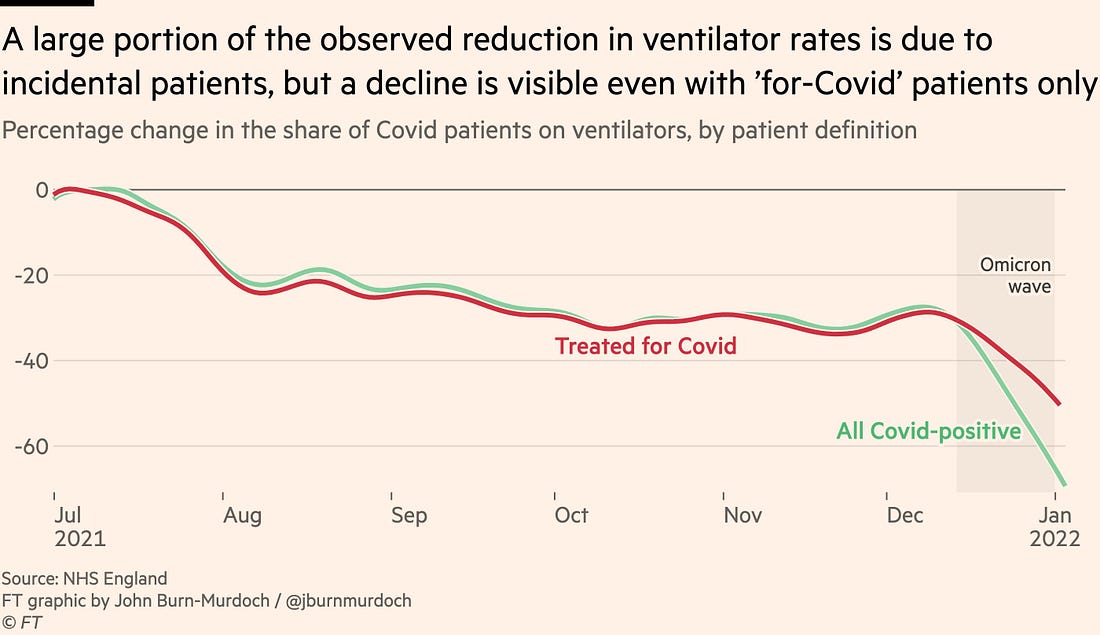
Right now, something like 15.5% of ‘for-Covid’ patients are ventilated, whereas 7.5% of ‘with-Covid’ patients are ventilated, so something like ~45% of all patients that are ‘with-Covid’ are also ‘for-Covid.’ Looking back at the start of the graph, we see 20% ventilated versus 28%, so that implies ~70% of all patients were ‘for-Covid.’ That’s a big drop.
It would be good to compare the number hospitalized ‘with-Covid’ with the number you’d expect from the baseline population, but we don’t have the baseline number, so we can’t do that analysis, unless there’s data sources I don’t know about.
On top of that, even the ‘for-Covid’ patients are being ventilated substantially less, about -50% from July 2021, versus about -30% at the start of the Omicron wave, so an additional -25% from there.

Eyeballing the graph has the number going from 70% to 45%, the stat here says 75% to 67%. The 70% vs. 75% is a rounding error in context, but the 45% vs. 67% is bigger, there’s no way to reconcile that with the graph above.
All such graphs need to be adjusted for the relative ages of the populations, to get the full context, as my understanding is that the Omicron wave still skews relatively young, so that’s another way in which it’s still going to get worse before it get better.
Also this data point: Los Angeles hospitals are two thirds ‘with Covid’ versus one third ‘for Covid.’
In terms of that, nursing homes are only now seeing the kinds of staff shortages and rates of illness that lead to more cases. To extent that things look good at first and then get worse when it seems like they should be getting better, this dynamic and similar things like it are the most likely reason.
Long Covid
An all time great headline.

Claiming to have Covid-19 was correlated with claiming to have Long Covid.
Actually having Covid-19 was not correlated with anything other than anosmia.
Restricting the analyses to participants with a positive belief and attributing their persistent symptoms to COVID-19 showed a positive serology test result to be associated only with anosmia (OR, 2.97; 95% CI, 1.58-5.57) (eTable 7 in Supplement 1). Similarly, confirmation of the diagnosis by a laboratory test or by a physician (vs the response, “No, but I think I had it,” and excluding participants who answered “I don’t know”) was also associated only with anosmia (OR, 4.29; 95% CI, 1.92-9.58) (eTable 7 in Supplement 1).
Their conclusion is polite but brutal:
The results of this cross-sectional analysis of a large, population-based French cohort suggest that physical symptoms persisting 10 to 12 months after the COVID-19 pandemic first wave may be associated more with the belief in having experienced COVID-19 infection than with actually being infected with the SARS-CoV-2 virus. Although our study cannot determine the direction of the association between belief and symptoms, our results suggest that further research regarding persistent physical symptoms after COVID-19 infection should also consider mechanisms that may not be specific to the SARS-CoV-2 virus. From a clinical perspective, patients in this situation should be offered a medical evaluation to prevent their symptoms being erroneously attributed to COVID-19 infection and to identify cognitive and behavioral mechanisms that may be targeted to relieve the symptoms.
I’m updating quite a bit in the direction of Long Covid mostly (not entirely) being people often having health issues, and them then blaming those health issues on having had Covid, rather than on Covid causing long term symptoms often in people who didn’t have severe disease. No question that those with severe disease often have lasting damage, but yeah, if you feel like it finally happened and was no big deal, it was almost certainly no big deal.
In Other News
Looking back, no one could have predicted that politicians and regulators would betray our trust, or that repeatedly betraying the public’s trust would destroy public trust.
Man begs for positive Covid test to avoid visiting relatives.
Scott Lincicome feeling pretty good about his radicalization regarding repeated government failure and obstruction. I am Bart Simpson’s chalkboard repeatedly writing “I will not suggest using the free market to supply things people want.”
I don’t know what this is about but seems potentially quite the red flag, and worth passing along.


The problem with the ‘with Covid’ versus ‘for Covid’ distinction is that Covid can also screw you up in other ways. So the ‘for Covid’ population isn’t the full story. In relative terms, the statistic still seems super useful.
Reminder, if you don’t have any symptoms, there’s no need to go to the emergency room or hospital, such people are clogging up the works in Vermont and everywhere else.
This thread is advice on what to do if someone is infected. Most of it seems reasonable (although not complete, she doesn’t mention Vitamin D, Zinc or Fluvoxamine). The part where she says to go out and get vaccinated after you’ve been exposed doesn’t make any sense to me other than as ‘one must recommend vaccination at all times no matter what’ but one can ignore that and look at the rest.
Pandemic or no pandemic, one man is still trying to find the answers to life’s persistent questions.

Scott Sumner looks back on what it was like two years ago, when the pandemic could potentially have been contained, but we didn’t know what we were dealing with. Since China did successfully contain it within China, it’s fair to think there’s a good chance that the same measures taken earlier would have contained it before it got elsewhere. How realistic that counterfactual is, and what that would take, is an important question going forwards. The necessary effort would not have been small or cheap. Do we have any good examples of containing something this hard to contain by acting early and aggressively on a (relatively) small scale?
A fully told story, in one Tweet.

For context, he was referring to this particular lie.
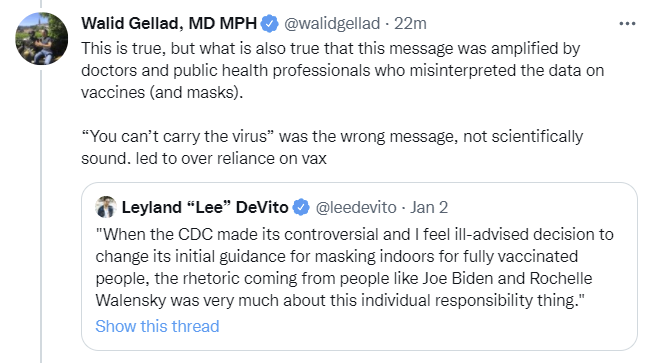
Not Covid
Or is it? Scott Alexander reviews Don’t Look Up (Spoilers).
My initial review of this movie was to note the cast looked amazing, and then say, and I quote, “I am not seeing this movie because I don’t have to and you can’t make me.”
I felt like I’d already seen the real world version and the movie would only bring pain, which more information has only confirmed. I do appreciate those involved for trying, and they’ve provided a baseline from which one can discuss important matters, but in the meantime every time I had the option to see or hear or read about this movie, my life got worse, until Scott’s review recapped it sufficiently painlessly that I now feel as if I’ve seen it on a different level than the one in which I’d ‘already seen it’ by default.
Scott’s review attacks the situation from an interesting angle, which is how to determine who to trust and what it means to Follow the Science without accidentally simply listening to power and thus Following the Science(TM) rather than making your beliefs match physical reality.
That’s been a lot of what this two-year project has been about here. At best, the official faces of Science(TM) has been behind, too slow to react to new information, only later doing somewhat reasonable things. At worst, they have outright lied to us about how the world works and given us orders that were Obvious Nonsense.
The only solution is Think For Yourself, Shmuck. There’s no easy set of rules to doing that, other than P(A | B) = P(B | A) * P(A) / P(B).
Not only is there No Royal Road to Wisdom, but even the poem No Royal Road to Wisdom, that often ends the Secular Solstice,is wrong about the road to wisdom. It reads:
The road to wisdom
Is easy to express
You err and err and err some more
but less and less and less
And no, that’s a beautiful poem and most people would be improved by taking it more to heart, but that’s wrong too, that’s the road the schools teach us. That’s ultimately the road to not thinking at all. That’s the road they want you to take. You don’t want to err less. You want to err on more interesting levels, in more advanced ways. You want to always be pushing at the level where you err at the right rate, or else you’re not learning much. Which is a subtle difference, but supremely important in the end.
One of the biggest problems with the Trusted Authorities is that if it’s very important that they never be seen as importantly wrong, it’s extremely difficult to ever be importantly right. You can only claim that which is certain, so you can only be unimportantly right. Or you can manipulate the narrative.
The Litany of Tarski is closer. Thus:
If a comet is coming to destroy the Earth, I desire to believe that a comet is coming to destroy the Earth.
If a comet is not coming to destroy the Earth, I desire to believe that a comet is not coming to destroy the Earth.
Let me not become attached to beliefs I may not want.
Some other time I should notice all the ways in which that last line is really weird.
I do my best to synthesize the information I get from a wide variety of sources, combine it into as coherent a physical world model as I can, and synthesize what it all likely means, while doing my best to think probabilistically. Then, you the reader can decide whether my reasoning makes sense, and whether my sources check out, and any other factors to consider. Thus you decide how much you want to rely on me in turn, the same way I am relying on others. It’s the best we’ve got.
I’d like to have something better to put here, but I don’t, and I don’t believe anyone else does either. Predictions are hard, especially about the future.
Also, a reminder that people don’t love science all that much and this isn’t new. They didn’t want to go to the moon, they were skeptical of the polio vaccine, they didn’t care about computers and all that.
And that if you think we’re serious about climate change, well, sometimes it’s not you, it’s the incentives, like when they tell you to fly empty airplanes thousands of times across Europe to maintain landing slots, and you still don’t have a carbon tax.
Moderation in All Things
Lastly, a note on moderation policy for both Substack and WordPress.
So far, I haven’t needed a real one, and have only deleted one post that wasn’t either a simple error correction or obvious spam, and the contents of my comments section especially on WordPress have mostly been high quality. Having to find the blog and decide to comment was filter enough.
However, recently I’ve gotten a lot of new readers, and a number of new frequent commenters, and I’m seeing a higher proportion of comments that make my life worse rather than better, and likely make other lives worse as well. In particular, I’ve also gotten a higher proportion of comments that are mostly advocacy and aggressive rhetoric rather than gears-level explorations, and often heavily political, which I’d prefer to avoid.
Please strive to post comments that make the world better rather than worse, and avoid comments that make my comments section look like every other content section on the internet.
Also, please be aware that you cannot edit your comments, so strive to get it right and to avoid having to put out 3-5 quick reactions in a row to the same thing.
Typical comment sections are full of rudeness both to the author and to others who comment. They also have a lot of ad hominem attacks, repeatedly make the same points without anything new to add, and are neither careful nor precise with claims that anyone who doesn’t know something or agree with you something is clueless or stupid or isn’t paying attention, or others that are similar. The rightness of one’s ingroup against the outgroup is often taken for granted.
That stuff’s not what my comments sections are for, and if the garden is becoming sufficiently ill-kept, I’m not going to let it die by pacifism.
The goal is to share models and information (including links) and improve our understanding of the world, and also of course to make life better through other methods such as jokes and social connections and all that.
For now, the new policy is that if a comment makes my life actively worse to a sufficient extent, I’ll say that explicitly (as in “This comment made my life worse”), and one can consider this a polite request to update on that information and stop it, but continue to have a very high bar for deletions or bans and hope we can still have nice things. If that doesn’t work, I’ll escalate.

I don’t know that recreational skydiving is particularly risky, see e.g. https://skydiveperris.com/blog/risks-of-skydiving/; their comparative analysis isn’t necessarily something I would hang my hat on, but the raw data seem sound.
I know a few people who jumped out of aircraft on the clock and took pretty thorough orthopedic beatings for their pains, but no doubt some of the difference is explained by carrying a bunch of crap and (sometimes) having to land near some objective or other that wasn’t chosen for jump-friendliness.
I notice that it’s not exactly an unbiased source, and also that I don’t believe it, but that I don’t have enough motivation to check since it wasn’t actually important, just a rhetorical example. Hopefully someone else can confirm/deny.
Sky diving is fairly safe, less than 1 in 100,000 chance of dying in a single jump: https://uspa.org/Discover/FAQs/Safety
Admittedly this may also be a biased source, but they have data and show their work.
The data for US and UK (both from biased sources, but consistent with each other) are also included in the wikipedia page on micromort, which may also be helpful for comparison with other risks.
https://en.wikipedia.org/wiki/Micromort#Leisure_and_sport
A more appropriate rhetorical example from the same family could be BASE jumping or wingsuit flying, which is in fact quite dangerous.
Right. I’m not looking here to make a case against skydiving, it was simply the go-to-in-brain example of an obviously not-safe thing to do that wouldn’t ruffle feathers. So shrug.
(I do think that if you think doing this is *safe* then this must be some strange use of the word safe that I wasn’t previously aware of, notwithstanding the air travel fallacy.)
In defense of David Leonhardt, specifically, since taking over the NYT Daily he’s provided a balanced assessment of the covid situation (e.g., he’s advocated against looking solely at case counts for months). I’ve found it rational and refreshing.
All this to say, the tweet thread and article you’re referring to are not “new” positions as far as his writing is concerned. Rest of NYT I can’t speak for.
Side note: new(ish) to your blog and enjoying it. Thank you.
You’re very welcome.
I have a longstanding NYT-boycott in place after what they did to Scott Alexander (plus them being them), so I haven’t been following. It’s a pleasant update to know he’s been on that ball.
You write: “But compared to March 2020, this is nothing. We got this.”
Can you clarify what you mean by this? It seems likely deaths, the number of people sick and the strain on hospital capacity are all going to meet or surpass March 2020 – do you just mean there is less uncertainty and restrictions warranted?
Two additional points:
1. while I largely agree that governmental restrictions should be based on hospital capacity concerns rather than vague public health normative concerns, there are very few countries like the USA that can manage life without restrictions without overwhelming hospitals. IE Canada has 1/3rd the ICU capacity of the USA – Canadian provinces are imposing severe restrictions not to be righteous but because the system cannot function otherwise.
2. Given the number of people going to get Omicron + the likelihood of additional variants; how should governments plan to deal with Covid 1 year, 3, years, 5 years out etc. This seems to be a super critical question with so little people discussing it. Given the lack of discourse, it seems worthwhile to begin discussing this problem.
In terms of death rate, I think we missed a lot of deaths in early 2020 and I’m not convinced the peak this time will be higher than that one. In terms of cases, a ton more yes, but also we don’t have two years in front of us and we’re not facing potential supply chain disruptions and loss of civil order that could bring us all down, or a stock market/economic collapse, and we’re not taking extreme counter-measures. We got this.
The load on the hospitals is much less then what we predicted in March 2020 under total infection. Vaccines contribute, but also hospitals becoming more efficient in treating COVID.
1. In Quebec they just said the unvaccinated can’t buy hard liquor, so I’m not exactly buying the ‘not to be righteous’ argument here, not fully anyway. I do sympathize with desire to flatten the curve a bit for a few weeks, but I still wouldn’t be doing it beyond making sure private prevention had a green light.
2. My basic PoV is that previously infected people don’t get very sick, so even if a new variant re-infects everyone, it’s unlikely to be an especially scary illness, and we can simply accept that our world has one more annoying illness in it forever. Otherwise, back to normal.
My “long covid” experience matches the study. For myself (and for another friend) the only symptom left after several months is smell related. Same weird one – my body odor smells completely wrong to me (and only to me). My friend has the same thing. Interesting that this is the only thing that got different, possibly because the smell was so ingrained or some such. Nothing else smells any different, no do I have less of a sense of a smell (as far as I can tell)
Is it possible that your body odor has actually changed? My understanding is that a lot of body odor is determined not by the body, but by the community of microorganisms living on various parts of it. It would not be totally surprising if an infection, or a treatment protocol, somehow changed the community of microorganisms living on your body (though it seems to me that this would be more likely if you had a bacterial infection and/or antibiotics rather than just a mild viral infection).
My wife and a few other people who I subjected to ignominy of smelling my armpits on purpose, say that it smells exactly as before. And to me the smell is _really_ weird, I would definitely notice that much difference in odor on someone else.
it would make sense if schools spread covid more than other places kids are likely to be at, but do they actually? return to school surveillance in la county showed more kids with covid right before return to school than during school itself. (la’s surveillance testing and quarantining might be what caused the drop, though)
Prediction: You’re gonna need to escalate. Some people just can’t control themselves from making partisan political comments – it’s similar to other addictions
Eventually I have zero doubt, but last time I gave a warning things improved (but since then I got a lot of new people) so I have hope this can buy a bunch of time. Free speech is a big deal for me and I prefer to not break the seal.
Re: Long Covid: it needs to be said that those who hyped up long covid are responsible for the suffering of millions of people
I’m enjoying this blog more and more, because it feels to me like it is embracing more complicated and unclear – and thus (probably) more accurate framings than e.g. a year ago. Or maybe I’m reading it more attentively, but I do seem to notice a shift.
> Then there’s the ‘vax related deaths’ claim, and yeah, stating that as fact does seem exactly like what a ‘dangerous misinformation’ policy is designed to stop.
If I understand you correctly, this is referring to the 6k vaccine related deaths figure? That’s just 0.006% for 100 million doses, do you think that’s absurdly high?
Now I’m in no way a fan of this Trumpist politician, but after all, we know that:
a) A not-insignificant fraction of people get pretty knocked out after getting the vaccine, and there is a small fraction of people – in particularly very old ones – who won’t survive getting knocked out for a few days. Replace “get knocked out” with “get a fever” if you want.
b) An insignificant fraction of people get heart issues from e.g. the Moderna vaccine.
c) There may or may not be thrombosis issues, some people have allergies, etc.
All in all, concluding that an insignificant number of deaths (6k/100million = 0.006% (!) ) are vaccine related doesn’t seem like object-level false to me. What’s E[number of vaccine-related deaths per 100 million doses] in your personal model of the world? It’s certainly > 0 because the definition doesn’t include vaccine-related lives saved and I’d be very surprised if you thought it was 100% certain that this number is 0..
I mean, no, I’m obviously not 100% confident the number is zero (and it would be pretty surprising if it was actual zero) but in context it seems clear the claim is asserting a level of confidence/evidence/fact-ness that is very much not there, and is engineered to give a false impression. Note the Trump method of *not* doing this – “Many people are saying that…” – is designed so he can claim *anything* and then turn around and claim it wasn’t false, while still getting the intended effect.
Well yeah, but my point is that if the claim is not clearly false on an object level (and may even be true), it’s hard to call it “misinformation” because you disagree with something implicit to it. I tend to reserve that word for things that are also not true.
I mean imagine twitter suspends her for that tweet, and then in a year a study comes out that estimates the number of vaccine-related deaths as begin 10k. Imagine how absolutely vindicated she will look.
Edit: s/begin/being/
s/absolutedly/absolutely/
my goodness, I wish I had an edit button here.
Substack has an edit button, if you’d like you can pivot to there. Otherwise, it’s OK to have typos, it’s fine.
I strongly believe that saying “X is true” is misinformation if you have no reason to believe that p(X) is all that high, or that anyone else should either. If I say “The Jets are going to win next week” that’s not impossible, but it damn sure is misinformation, and would remain misinformation if the game had been played but we were both unaware of the score, and I said they had won. And if I say they won 35-24, well, it’s not like it’s *impossible* but that’s *obviously* misinformation, although not dangerous.
Anyway, that’s the most I think need be said on this on my end.
Yeah I subscribe via the wordpress RSS feed, but pivoting to substack for the edit button probably makes sense.
> I strongly believe that saying “X is true” is misinformation if you have no reason to believe that p(X) is all that high, or that anyone else should either.
No, this is two different things. The first (1) is “if you have no reason to believe P(X)” is all that high, and the second one (2) is “or that anyone else should either”.
Morally, maybe you’re a bad reasoner or whatever if you push something you have bad reasons to believe, but that’s most of us if we’re being honest. That’s (1). But in terms of a twitter ban, the people censoring it had better be sure of (2), i.e. that the position is at its face unreasonable. And I don’t think this is the case, 6k vaccine deaths is such a small number that I’d be suspicious of anyone claiming they’re confident it’s less, see my previous points for some “reasons”. You’re basing your status of “misinformation” on the fact that you don’t trust Greene’s reasoning abilities, I don’t either, she’s a politician. But I’m not comfortable to start censoring people based on we think they’ve reached their statements. I’ve often held people for much stupider than it later turned out to be, I don’t think twitter is above this either. And “they banned X for misinformation but then suddenly scientific consensus is X” is something I’m pretty sure I’ve seen mocked also on this blog.
“Do we have any good examples of containing something this hard to contain by acting early and aggressively on a (relatively) small scale?”
SARS1 is about as close of an example as you could get.
It wasn’t nowhere near that hard to contain, it was roughly 10 times less contagious (perhaps more, it’s hard to estimate precisely)
It also sounds like significant symptom onset was closer to when people became contagious.
Yes, they are different diseases. But it is unusual that there are two diseases so closely related as SARS1 and Covid, and that one was contained, but not the other.
If the question was about what disease like AIDS was successfully contained and eradicated, it would be much harder. Maybe Ebola?
For both SARS1 vs Covid and Ebola vs AIDS, an important factor seems to be asymptomatic infectiousness. For Covid, a significant fraction of the infectious people never get systems, while for AIDS, there is a long time before symptons appear.
From one perspective, this is good: we know how to crush new diseases whenever they consistently give us symptoms. From another perspective, if we actually want to stop future pandemics, dealing with asymptomatic spread will have to be a priority.
This seems like the rule. If we always get clear warnings in the form of symptoms, unless the thing is super infectious (a lot more than Covid-19) it’s not that hard to contain such things. If we don’t get clear warnings, then we lack good options, and if we don’t catch things very early (e.g. before anyone gets out of some confined area) we’re toast.
Number of warning strikes: at the port of LA+LB, they’ve announced on oct. 25. that they would introduce a quadratic demurrage on incoming containers on nov. 1., then delayed it successively to nov. 15., nov. 22., nov. 29., dec. 6., dec. 13., dec. 20., dec. 27., jan. 3., and currently to jan. 10. On dec. 31. they announced they’ll start charging a similar fee structure for outgoing empties. The latter may make more sense, since (according to my current state of confusion) part of the reason for the port and related facilities overflowing is that “carriers” (the companies running the ships; “shipper” refers to the companies buying transportation) calculated that as Asia->US rates went up, it wasn’t worth their ships’ time to stay in port handling empties.
On the long covid study — I can accept that belief of infection might be more associated with more symptoms than confirmed infection. But if you look at the paper, their Model 2 (controlling for only serology results) shows 10 long-term symptoms that are associated with positive serology. The most prominent (Table 2) are fatigue, poor attention/concentration, and breathing difficulties. The first two are likely the classic ME/CFS symptoms of post-exertional malaise & brain fog that have consistently, since the start of the pandemic, been reported following infection (and in the same cohorts seen for other viruses, e.g. Epstein-Barr, CMV, etc).
Model 3 in the paper — this is the model that controls for both belief of infection & serology, attempts to use logistical regression to tease out how much of the reported fatigue is explained by belief vs. serology. In this model, classic long-covid symptoms such as fatigue are attributed more to belief. The fact that belief can explain the signal better than serology, within the assumptions of their model, which assumes relationships between variables are linear, does not mean that belief is causative for all (or even most) long-covid cases. Regression models can’t be used to prove causation in that way. Think of the asymptomatics in the sample who were never tested — what is more likely to predict who has long-term symptoms? Asymptomatics who then contracted long-term symptoms of course believe that they had it. But the asymptomatics who have no long-term symptoms, and didn’t know they were sick — they have positive serology but negative belief in infection. So it makes sense that belief correlates better with symptoms if you regress on both. Model 2 still shows that positive serology predicts many statistically significant, long-term symptoms.
Anecdote on confusing instructions/incentives. Several weeks ago all four of my family members got PCR test for covid (for travel). Only one came back positive. (person was <16 years old and had the sniffles/mild fatigue 10 days before) Got a call from the state health department telling us positive family member should quarantine 10 days. Negative family members should quarantine 20 days. Wait what? Please repeat. Yes, double quarantine for negatives who were exposed to a positive. This advice was treated with the correct level of respect. If this isn't crazy, please help me understand.
If you assume that the positive was positive on day 0,they then could infect the negatives for 10 days, after which they would need 10 more days to recover.
Not saying it is sane, but I believe that is the logic.
Hi Zvi,
(Fairly) long-time reader. I’m planning on doing a talk on personal Covid-19 decision-making at next week’s EA New Zealand retreat. (For reference, NZ is currently averaging a couple dozen delta cases per day in a population of 5 million, there is yet to be any Omicron community transmission because of our quarantine of international travelers, but historically quarantine has leaked enough to not expect this to last more than a few weeks. Much of NZ has seen close to zero community transmission since April 2020).
My current rough outline is:
– EAs should consider the Covid costs of their decisions, but don’t go overboard – consider costs vs benefits, don’t sweat the small stuff.
– At the moment, Covid risks are sufficiently low that “pretend it doesn’t exist” is pretty much right for almost everyone.
– Show examples from MicroCovid.org. Emphasise the orders of magnitude differences of Covid risk of some activities vs others (crowded bars are relatively risky, small outdoor meetups aren’t).
– What is the QALY gain from an averted infection? This is hard problem – the only paper I’ve found that tries to estimate it is this one (https://www.ncbi.nlm.nih.gov/pmc/articles/PMC7938736/), which is also based on US dynamics back in early 2021. Still, my ballpark estimate, translating QALYs to dollars, is that it’s worth around $10,000 NZ to avert one delta infection today. But there’s a good amount of variation – for young people whose most common close contacts are other young people, it’s likely a fraction of that (but vice versa for older people).
– Quantifying the QALY cost in dollars + using MicroCovid means you can do things like estimate the Covid cost of e.g. eating indoors in a restaurant – under $1 at the moment, and so not really worth worrying about.
– The government rules and messaging are heavily based around vaccine passports making venues much safer. Some people also think they should shun the unvaccinated privately out of fear of transmission. My claim is that being unvaccinated is a risk factor for Covid transmission, but it’s one of many (e.g. an unvaccinated homebody is a lot lower risk than a crowd of vaccinated partygoers), so it shouldn’t be a deal-breaker, and nor should a group being entirely vaccinated lead you into a false sense of security – especially when Omicron hits.
– Omicron is coming, the government will try to hold it off and may try to “flatten the curve” once it hits, but nothing we can do will stop tens of thousands of cases a day and probably the majority of the country being infected. Luckily, it appears considerably milder than delta (will update on the very latest figures right before the retreat). This may be shocking to a country that has been used to very little Covid.
– In a wave, “slowing the spread” has some value – to get more time for boosters, Paxlovid, child vaccination, and flattening the curve of healthcare capacity (NZ has just 4 ICU beds per 100k people, second lowest in the OECD). How much value? I’m not quite sure. My ballpark figure is that it’s an extra $1,000 per infection near the peak of the wave, but this is really just a number pulled out of thin air – maybe it’s a tenth of that.
– When calculating the “Covid costs” of an activity in a wave, you have to adjust for the fact you might avoid catching Covid from one activity but catch it at the next. That is, it increasingly makes sense to think of infections as “delayed’ rather than “averted”.
– Omicron will likely infect the majority of the country – but if you’re more careful than average, it’s possible to be one of those who don’t get it in the wave, and then maybe you’ll be able to avoid it for a long time.
– Is it worth trying to avoid it? Maybe – if you don’t mind/are able to avoid medium-to-high risk activities for a couple of months, and especially if you or a close contact is high risk. But you might decide it’s inevitable given your lifestyle. Still, even if you’re resigned yourself to contracting Omicron, it might be still a bit helpful if you don’t spread it at the peak of the wave, so lowering contact then may be good from an altruistic perspective.
– If you decide it’s time to act cautiously, then there’s still a lot of activities (e.g. outdoor mask wearing) that “cautious” people sometimes like to do, that are still not likely worthwhile even at the peak of a wave. There’s something an 80/20 rule with Covid risk – 20% of your activities producing 80% of the Covid risk. Try to mitigate risks rather than just cancel everything (e.g. hold events outside, use rapid tests if they’re in decent supply). Consider semi-isolating for a ~week before and/or after any high-Covid-risk events that you nonetheless think are important.
– Utilise intertemporal substitution when possible. If you expect Covid risks to get worse in the near future (as looks likely in NZ), then try to do *more* risky activities now (e.g. maybe prioritise visiting Grandma now over next month). If you expect them to get better (e.g. you or a vulnerable contact is about to get boosted, a big Paxlovid shipment is about to arrive, cases are just starting to fall), then there’s value in holding tight for a little while and making up for lost time later. If it looks like Covid risk is going stay relatively constant for some time, then adopt a level of sustainable level of caution (e.g. it may be risky to visit Grandma for the next couple of years, but what are you going to do, just never visit her again?)
What are your thoughts? Anything you disagree with? Anything important that I should add? Thanks for reading.
It’s NZ? Yeah, get vaccinated and otherwise treat Covid as if it doesn’t exist, very good, now where shall we have lunch?
I mean, how is it not that simple?
Once Omicron arrives, it might make sense to ‘flatten the curve’ but right now all they’re doing is postponing it, which doesn’t help unless you get Paxlovid shipments or an Omicron vaccine in time. I would say, once Omicron cases are starting to get to e.g. 10% of current (Jan 6) USA levels, then you’ll need to make a real choice personally, and at 1% you’ll need to actually think that through, but other than that, what’s the difference?
>It’s NZ? Yeah, get vaccinated and otherwise treat Covid as if it doesn’t exist, very good, >now where shall we have lunch?
>I mean, how is it not that simple?
Probably partially as a result of our former Covid Zero status, NZ has some of the most risk-averse Covid commentators in the world. Many of them wanted our largest city to go back into the highest lockdown level (where even takeaways and greengrocers are shut) because cases rose to about a 200 day back in October. Nowadays, some still recommend doing things like avoiding travel to regions with low (read: below 90% fully vaccinated) rates, or avoiding unvaccinated people altogether, or wearing masks everywhere even when it’s not mandated.
So I think it’s fairly likely that quite a few people who would attend this retreat have bought into those ideas – thinking it’s a moral imperative to reduce the spread of Covid-19, even with cases this low.
>Once Omicron arrives, it might make sense to ‘flatten the curve’ but right now all they’re doing is postponing it, which doesn’t help unless you get Paxlovid shipments or an Omicron vaccine in time. I would say, once Omicron cases are starting to get to e.g. 10% of current (Jan 6) USA levels, then you’ll need to make a real choice personally, and at 1% you’ll need to actually think that through, but other than that, what’s the difference?
Isn’t geting Pfizer boosters out to as many people as possible valuable? Currently, 8% of the population is boosted, but it’s going to rise rapidly with the eligibility date cut to four months just recently. 5-11 aren’t eligible for their first doses until Jan 17 – yeah, they’re not high risk but it’d still be nice if they could get vaccinated before facing peak Omicron.
Additionally, the situation in Australia has exploding cases leading to a massive testing shortage. It’d be good if the government had time to stock up more RATs. Maybe the answer is to just stop worrying about tests and assume you have it if sick, but at least now it’s needed for isolation payments.
Boosters are good, getting people boosted is good and if you are taking serious precautions but not getting boosted I consider that a pure contradiction. Only good reason not to boost is if you already don’t feel the need to care. Also securing some tests for later is good.
All those precautions are based on population-level dynamics, which no longer make any sense, or they’re based on being stupidly risk averse even if you think by default you never get Covid, and now that default is gone, so… I guess try to point out why that’s changed? I’d accept ‘OK, your previous actions might or might not have made sense, but we can assume they did, and still have a strong argument that you should stop caring now.’
> Still, my ballpark estimate, translating QALYs to dollars, is that it’s worth around $10,000 NZ to avert one delta infection today.
If you’re vaccinated and below 60 this figure sounds insane to me. How did you reach such a high ballpark figure?
I’m starting to think that the push for increased availability of testing is incompatible with the movement for relaxing all restrictions. The only way for restrictions to *truly* end is if going outside while actively infected with COVID becomes completely normal (as it was with the flu/cold to a large extent) however this brings up the question of why testing is needed in the first place, assuming you won’t be expected to change your behavior in any shape or form.
Instead, testing should be restricted to those who would be eligible for Paxlovid and those in contact with heavily immunocompromised patients. For everyone else testing should be abolished and using home test kits should be discouraged. Otherwise you’re still creating negative feedback loops where people test positive and entire communities start over-reacting. No test = no panic = no restrictions. Trump was right, though his ideas didn’t make much sense until we’ve completed the vaccination program.
I mean good tests are great. I’d love a good test for the flu so I knew where I was at if I got symptoms. If you know you have Covid, you should have an easier time getting a few days off, and be able to take the time to properly rest and recover; I believe the reports that trying to exert yourself too fast can impede your recovery.
I do agree there exist worlds where testing is sufficiently harmful that we’re better off without it, but I don’t think we will live in it.
Re bypassing the VRBPAC:
Formerly quite unusual, but getting more common as the crisis continues. Bet #1 (unverifiable): Janet Woodcock (acting director) is beating heads together to get this to happen faster. Bet #2 (verifiable): it goes back to “normal” once COVID-19 is no longer Public Health Enemy #1.
Re Novavax manufacturing:
Usually, manufacturing (domestic and foreign) is very tightly controlled for quality under GMP (“Good Manufacturing Practice”) guidelines, complete with random unannounced FDA audits of the factories. This makes good sense for domestically approved drugs.
But for the Novavax situation, where we’re domestically manufacturing something for export which is not approved domestically… is a bit of an unusual situation. Probably lots of arguing about it at the regulatory agencies.
Re: Macron, “I want to piss them off”:
The French verb used here was emmerder, where the root “merde” means, um, feces. Roughly, you might render it as “I want to <crap> all over them”, though that’s (slightly) less transgressive in French than it sounds in English; “annoy them” is the usual dictionary definition. But it is a very aggressive, mildly crude thing for the President to say. My French friends are mostly amused by his phrasing, but then they’ve run out of patience with the unvaccinated, as well.
Re: paxlovid supply
Don’t expect it to get better fast. Manufacturing it is hard, according to med-chemist Derek Lowe’s writeup at In the Pipeline. Certainly better by the end of 2022 and good supply in 2023, would be my guess.
Re: consistency vs dumb decisions
This made me laugh out loud with sudden recognition. Long, long ago in a galaxy far, far away I was learning logic from a textbook, now forgotten, which had the following exercise on implication from contradictory evidence: “Let x be a real number solution of x^2 + 1 = 0. Prove that you are the king of France.”
It was meant to make the lights go on, and it sorta worked.
Re: Don’t Look Up
Absolutely with you here. Just seeing the trailer made me flash back to ugly meetings with powerful people who either could not, or just would not look away from their own power needs. No thanks: been there, done that, already burned the t-shirt.
Re: predictions
The link ascribed this to Neils Bohr, but I’ve also seen it ascribed to Yogi Berra. I know of no connection between Neils Bohr and Yogi Berra, but it tickles me to imagine there might have been one. Sort of like Andre the Giant used to be driven to school by the absurdist playright Samuel Becket… what was the conversation like?
I think with Djokovic the vaxx passport is what’s stupid, but ultimately I’m glad they didn’t let him in. Far more worthy people have been vaxxed and haven’t seen families etc for two years. Playing tennis in front of thousands of people who’ve been in lockdown six times in two years, then require vaccination to watch him, seems as morally shabby than the mandate in the first place. It would be great if a way could be figured out to accept proof of infection as an equal of vaccination, but it seems we aren’t there, especially not in Australia. Like New Zealand, I expect a decade could pass before covid regulation does not in one way or another impact difficulty of travel. China and others likewise. In approx April last year, just before my second injection, I was naive enough to think I might try and visit Australia around now, ha! What a fool.
Testing shortages in the US makes me ponder that there is really quite a lot the UK got right (eventually), ultimately. I could click through a UK Government website now and by tomorrow morning have twelve lateral flows come through the door. I am supposed to be in Chicago in April and will need a PCR test 48 hours before departure for the country I’m heading to from there (Pakistan, long story). Is this achievable through the private sector for travel purposes or do I need to forget it? If the latter my trip is off.
Since you mentioned boosters mandates (which I assume exempts the recently vaccinated) I will repeat this comment from the last thread:
—
What happened in Israel, the mass revocation of vaccine passports due to skipping booster shots, can and likely will happen in America. Ditto for Omicron-specific boosters even if it is poorly justified given the observed virulence levels. We might be looking at the tightening of the screws, first sifting the unvaccinated away, and then those who don’t see the point of boosting (short-term vaccine passports), and then those who deem Omicron-specific boosters unnecessary. What about those who are temporarily ineligible for Omicron boosters because they’ve been recently vaccinated or boosted with regular vaccines, if in the <20% chance that Omicron boosters are made and mandated? Are they trapped in limbo?
This isn't the way to use vaccine passports as a "gateway to normalcy" if you keep an increasing portion of people in the dark, with a decent chance of those staying inside being kicked out of the system. I can't stress it enough since the system has a decent chance of entrenching itself, and my conspiracy theorist instincts tells me it will become exclusionary for decidedly non-public health ends.
—
Macron says he won't lock the unvaccinated up in camps, but if you were among the ranks of Gilets Jaunes, you have good reason to suspect this promise. We could easily be looking at a Nuremberg Laws – Holocaust scenario here, tho it is highly unlikely (<5%) at this point. What's more important is him finally tearing off his mask and using authoritarian language. This is the worst way to encourage vaccination and I expect the (re)vaccination rate to actually drop, because opposing the Health Pass is now a sign of Resistance against a discredited administration. After that comes Eric Zemmour.
Hey Zvi, great work as usual.
A few items:
– You have a small typo in “be consistent with decisions over which you have on control.”
– The Bari Weiss link casts doubt on the Moderna (and not Pfizer for some reason?) vaccine for young men beginning at “One knee-jerk reaction to the more mild Omicron virus has been to push boosters on young people, despite no supporting clinical data and serious concerns of myocarditis complications.” It includes a link to this tweet advocating for a ban of moderna shots for men under 40.
You praise the links calling them “transparently correct” but I presume you did mean to extend that to the vaccine skepticism given the rest of your writing. You may or may not want to address it.
– Please be harsh on comment sections, it’s vital for their growth.
Hey Zvi,
I’d be interested in predictions on what will happen with covid naive societies and Omicron. There is chatter about China’s containment efforts beginning to crack. Given their vaccine rollout, their effectiveness, your priors on previous infection, and the severity of Omicron, what is a good/bad spread for covid deaths in China especially (or any other covid naive society like NZ) when they inevitably(?) open up.
I realize I’m asking for a lot here but I can’t think of anyone better to ask.
Regarding the Popehat tweet, the ambiguity is definitely unintentional, if you follow him it’s very clear which side he has picked in the culture war.
I think that makes it better.
>Which is misinformation, and is dangerous. I also think that censoring that kind of statement is a reasonable thing to consider doing. But the rules seem to consistently get written in a way that does not differentiate between this and a similar true or good faith statement, and instead give power the ability to censor whatever they dislike.
Zvi – I am going to try hard here to respect your comment rules.
You title this section “The Ministry of Truth”, obviously implying 1984, etc.
You then go on to rationally analyze every object level question involved in the story. I want to disregard every object level question about Greene here.
We all recognize that these “strikes” and decisions about what is “dangerous misinformation” are being decided by Berkley 20-something’s at Twitter HQ right? with the White House putting their finger on the scale when needed.
By seriously entertaining the object level questions your are implicitly giving up that they have already created the Ministry of Truth, they have the right to decide what is “dangerous misinformation”, we have no choice but to accept their opaque “decisions”. You, right here, right there, are actively building the Ministry of Truth by taking the object level questions seriously. I mean my god, what even is the point of reading 1984.
This pains me greatly, because if you, of all people, have already given up this ground then we are well and truly f***ed.
What is worse is that I know that you know this. Yet you do it anyway with little or no irony. Which is truly disheartening.
I do not see asking the question ‘what exactly is going on and under what justifications’ as justifying what it going on. We need to be able to describe what it happening, and evaluate under what conditions we can expect to be censored or not censored, and react based on what is. Evaluating what is going on is not an endorsement, nor is it building the ministry. We need to focus on first order considerations – understanding the world – and not worrying about arguments being soldiers. E.g. if MTG is spreading misinformation, I desire to believe she is spreading misinformation. And if not, not. And if the ministry is evaluating information reasonably or not, same deal. And if fingers are on the scale to some extent (and the question is the extent, not whether), same deal.
I do see this alternative point of view, but I think it’s wrong.
Let me go back to what you actually said: “I presume it was false, especially given the previous tweet, and that she was claiming a similarly massive number of (as far as I can tell, completely fictional) deaths from vaccinations. Which is misinformation, and is dangerous. I also think that censoring that kind of statement is a reasonable thing to consider doing. But the rules seem to consistently get written in a way that does not differentiate between this and a similar true or good faith statement, and instead give power the ability to censor whatever they dislike.”
Your conclusion on the last offending post is technically correct, however it is already possible to infer a correlation between COVID vaccination and a increased number of deaths as such, at least on the surface, and (presumably in good faith and with some bias) Greene changed it into a causation for her argument. The deaths are probably not fictional but certainly attributed to vaccine side-effects, rightly or wrongly, to different extents. This is where statistical analysis will be useful to determine whether existing preconditions or vaccine side-effects are the larger risk factor towards such deaths, and it isn’t being done.
Misinformation isn’t dangerous as far as readers are able to evaluate its truth value according to their own epistemic framework. Disinformation and propaganda are, but the better weapon against them will be a inquisitive mind rationalists like you are seeking to build. And I don’t think any level of censorship, on a societal level should exist, because all ideas are entitled to be expressed, even falsehoods or hate speech – absolute freedom of speech is the ideal that has barely been realized even in democratic and liberal societies.
However, within a platform, it is permissible to maintain a standard of speech (even if Neo-reactionaries will allege about the Cathedral or the argument of institutional conformism, which might be in play here) – Gab and Urbit are indeed ostracizing left-wing opinions, despite their claimed commitment to (right-wing) freedom of speech. In my eyes, it is about building various competing institutions that promote various kinds of ideological expression, which the Twitter-Gab dichotomy will turn into along the partisan divide. If you don’t like it, leave and start your platform, or join the platform you sympathize with ideologically, which is what MTG has done, joining Gab. It might be useful to revisit the post from Astral Codex Ten on Twitter and Gab’s content policies.
What I’m replying to with this is probably a good way to think, to your credit.
But however I deem looking at the outcome more useful:
– Provaxxer will consider it to be removing harmful information that challenge the Science and their officially-sanctioned narrative about the effectiveness and safety of vaccines. They will hold onto Twitter for this good gatekeeping job.
– Antivaxxers will consider it to be another validation of Twitter being a pro-vaxx agitprop operation that does not tolerate positions they consider correct. They will hold onto Gab for this rescue of a high-profile politician.
– It is another incident of the on the track record of Twitter actively taking an explicit stance in American partisan conflicts and “cancel” the opponents of their alleged Democrat benefactors, since Trump. This is one of the ways Gab justify itself, as the Conservative-GOP opponent to Twitter’s Liberal-Democrat bias. However, Gab users are as willing as Twitter’s management to ostracize left-wing views.
– Conservatives have long been on a crusade to remove Liberal political influence and to entrench their ideological dominance. Consequently Gab and its users/benefactors will position themselves as crusaders to shut down those “propaganda operations” and to install themselves as the dominant, if not the only officially sanctioned, social media outlets. This is the meaning of Vance’s tweet, coming from a Paleolibertarian angle. And to moderates, such high-profile “cancellations” serves as arguments to converge onto the Conservative position.
Twitter is basically shooting themselves in the feet and ensuring their destruction in a potential GOP victory in 2022/24. They should plan for this possibility and explore HQ location outside of the US e.g. Canada or Ireland should this happen.
I remember Andrew Gelman had some old blog posts complaining about the tendency (among journalists and certain social science types) to overhype second-order effects relative to first-order effects. Zeynep’s phrasing is unusually crystalline, though, so perhaps not an instance of Stigler’s law of eponymy.
A related formulation (of Gelman’s) that I’ve always liked: “Just because something is counterintuitive, it doesn’t mean it’s true.”
> I especially like the (intended or unintended) ambiguity here
Knowing the @popehat account a bit, it was fully intended and he didn’t mean Twitter.
Pingback: Omicron Post #13: Outlook | Don't Worry About the Vase
Just wanted to drop a note and say I love your blog, it’s a long read and I appreciate it every time. I learn a lot and I find so many new authors to follow when you link to blogs, Twitter handles and articles. It makes my world… bigger? And new sources are refreshing. Thank you :)
I think you’re misinterpreting the school/suicide chart. The period from March to June 2020 listed as “true lockdown” was not a period of school closure without remote learning, that was when basically everyone was doing remote learning. The period listed as “hybrid” is hybrid in the sense that some students were in school, some were doing remote learning, and some were doing some combination of the two (it even says “most states open for in-person instruction”).
If anything this is more consistent with “remote learning reduced suicide rates relative to in person learning” though I think it would be too big of a leap to go there (IIRC there was a general decline in suicides at the beginning of the pandemic).
Thanks for running this excellent blog, Zvi, and thanks to all the commenters here who make the comment section not terrible.
Recently ran across this medium article claiming that Israeli Ministry of Health data shows a notable (~2500 total) number of excess deaths attributable to vaccination in age 20-49: https://steve-ohana.medium.com/young-adult-mortality-in-israel-during-the-covid-19-crisis-ff7456cff74f
Curious what other commenters think. More generally, there is a (antivax) line of argument I’m seeing more of, which does not claim that the vaccines don’t work, per se, but claims that excess deaths due to vaccination are wildly under-reported and probably on the order of 1/1000. I would be curious if anyone here knows of a good study looking at all-cause excess mortality amongst the vaccinated.
I consider it absurd straw-grasping. You have to assume you are up against an adversarial information flow that maximizes for the thing that would sound maximally suspicious, and compare what you hear and see to that versus what you’d expect to see on average if the vaccines were harmless, and what you’d expect to hear and see if this was killing one person in a thousand in that age range, and ask which one this looks like.
Zvi has an excellent answer, but some more on the substance – they look at the reported covid deaths, see excess mortality above it, and decide to conclude “the only thing that could cause it is vaccination”. Unlike, say, longer term complications from covid, which couldn’t possibly happen, right?